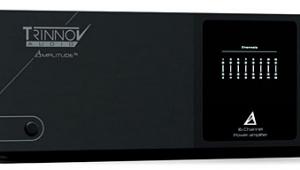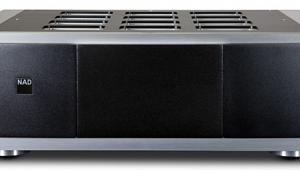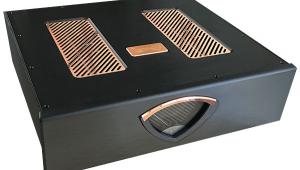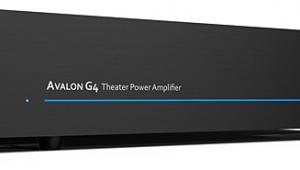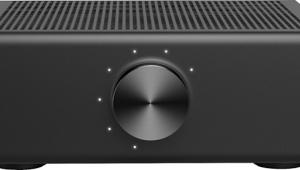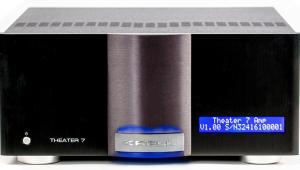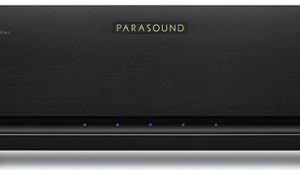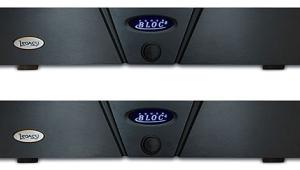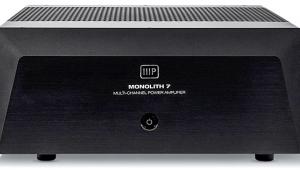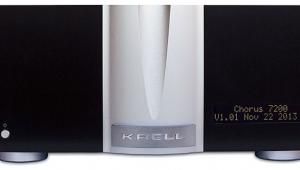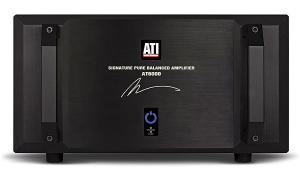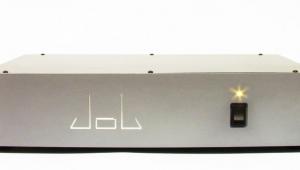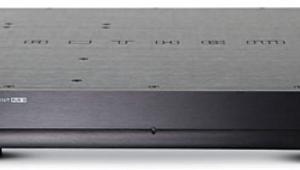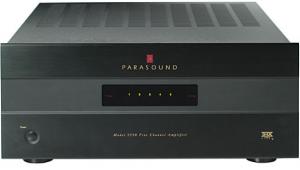Test Report: Outlaw Audio Model 975 Preamp/Processor Page 3
Test Bench
DOLBY DIGITAL PERFORMANCE
All data were obtained from various test CDs and DVDs using 16-bit dithered test signals, which set limits on measured distortion and noise performance. Reference input level is –20 dBFS, and reference output is 200 mV. Volume setting for reference level was Max Vol. All level trims at zero; except for subwoofer-related tests, all speakers were set to “large,” subwoofer on. All are worst-case figures where applicable.
- Distortion at ref. level (THD+N, 1 kHz): 0.02%
- Noise level (A-wtd): –75.0 dB
- Excess noise (with sine tone)
- 16-bit (EN16): 1 dB
- Frequency response: 20 Hz to 20 kHz +0.5, –0 dB
STEREO PERFORMANCE, STEREO ANALOG INPUT
Reference input and output level is 200 mV; volume setting for reference output level was Max Vol.
- Distortion (THD+N, 1 kHz, 8 ohms): 0.02%
- Noise level (A-wtd.): –82.6
- Frequency response: <10 Hz to 160 kHz +0.5, –0 dB
STEREO PERFORMANCE, DIGITAL INPUT
Reference level is –20 dBFS; all level trims at zero. Volume setting for reference level was Max Vol.
- Distortion at ref. level/0 dBFS: 0.02/0.003%
- Linearity error (at –90 dBFS): 0.07 dB
- Noise level (A-wtd): –74.8 dB
- With 96-kHz/24-bit signals: –82.8 dB
- Excess noise (with/without sine tone)
- 16-bit (EN16): 0.75/0.75 dB
- quasi-20-bit (EN20): 10.75/10.3 dB
- Noise modulation: 0.4 dB
- Frequency response: <10 Hz to 20 kHz +0.5, –0 dB
- With 96-kHz/24-bit signals: +0.6, -0.1 dB, 10 Hz to 44.3 kHz
BASS-MANAGEMENT PERFORMANCE
Measured results obtained with Dolby Digital test signals.
- Subwoofer-output frequency response (crossover set to 80 Hz): 24 dB/octave above –6 dB rolloff point of 80 Hz
- High-pass-filter frequency response (crossover set to 80 Hz): 12 dB/octave below –3 dB rolloff point of 83 Hz
- Maximum unclipped subwoofer output (trim at 0): 7.2v
- Subwoofer distortion (from 6-channel, 30-Hz, 0-dBFS signal; subwoofer trim set to 0): 0.08%
- Crossover consistency: bass crossover frequency and slope were consistent for all sources and formats.
- Speaker size selection: all channels can be set to “small”
- Speaker-distance compensation: available for all main channels.
Model 7125 power amp
ANALOG PERFORMANCE
Line input to speaker output. Reference input level is 200 mV; reference output is 1 watt into 8 ohms.
Output at clipping (1 kHz into 8/4 ohms)
- 1 channel driven: 242/340 W (22.8/24.2 dBW)
- 2 channels driven: 190/264 W (22.8/24.2 dBW)
- 5 channels driven (8 ohms): 160 W (22.0 dBW)
- 7 channels driven (8 ohms): 141 W (21.5 dBW)
Distortion at 1 watt (THD+N, 1 kHz)
- 8/4 ohms: 0.02/0.04%
Noise level (A-wtd): 95.1 dB
Frequency response: 20 Hz to 20 kHz +0, 0.3 dB
The Outlaw’s Model 975’s test bench behavior was excellent throughout, headlined by superb linearity and really superb “excess noise,” our measure of digital-to-analog efficacy with very small signals. Conventional signal-to-noise result (-74.8 dB re: 200 mV, a little less than 1 dB shy of theoretical perfection) was merely very, very good, indicating that analog-component noise, rather than any digital misbehavior, was probably the source. Our frequency-response tests consistently displayed a roughly 0.5 dB rise over the top octave (10-20 kHz), though I suspect this was a reflection of out-of-band noise-shaping residuals rather than actual response: Inserting a 22 kHz “brickwall” into the test circuit dropped the amount by about half.
There’s very little more to say, other than to reiterate that the Model 975 performed accurately on every test. It is worth noting that on our all-channel, full-scale 30 Hz sub-output torture test, it delivered one of the lowest distortion results we’ve seen (0.08%) while producing more than 7 volts output, which is more than enough signal to launch any powered sub on the market into the next room. Twice. –D.K.
Bottom Line
In terms of intrinsic sound quality, I believe that Outlaw’s Model 975 can hold its own against preamp/processors costing two and three times as much (and probably a good deal more) — but then I am not one who believes that electrons care much about $6 capacitors or cryogenically drawn wire. As for the Model 7125 power amp, this sub-$1,000, 7-channel model’s impressive dynamics and quiet, clean playback surely make it one of the best audio-power values available.
But despite my enthusiasm for the Outlaw pair, anyone considering the 975 owes it to themselves to draw up a list of stuff they will not find in the box, starting with networking capability to stream audio and video, and multiroom features. The first absence can be addressed by a Blu-ray player or set-top receiver; the second can be easily solved by adding another component or two. (Another absence, that of multichannel inputs and/or DSD decoding, will probably be noticed only by the few surviving SACD devotees: me, and two or three other guys.)
To wrap up, Outlaw’s conjuring of an A/V nexus that performs so well for so little is no mean feat. The 975 doesn’t actually do a whole lot other than play music and movies in the most important surround and 2-channel modes. But it does it with as little intrusion as possible and no sonic fingerprint of its own. And isn’t that the whole idea?
